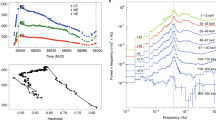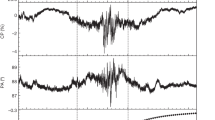Abstract
Quasi-periodic millisecond oscillations in the X-ray flux of two low-mass X-ray binaries, GX5–1 and ScoX-1, were recently reported1–4. These quasi-periodic fluctuations are very similar to those observed in the soft X-ray flux of some dwarf novae in outburst5,6. Guided by this analogy, we propose here that, as in the case of dwarf novae7, oscillations in low-mass X-ray binaries are caused by transient magnetic fields generated by turbulent dynamo action in the boundary layer and possibly in the corona of the accreting neutron star. The magnetic fields created in this way are too weak to channel the accreting material, but are strong enough to influence the heat transport in the neutron star corona and boundary layer and to cause bright spots with lifetimes of a few rotation periods to appear randomly on the neutron star surface. The rotation of this star's outer layers, together with the appearance and disappearance of the spots at random azimuthal positions, then gives rise to oscillations with the coherence characteristics reported in the observations.
This is a preview of subscription content, access via your institution
Access options
Subscribe to this journal
Receive 51 print issues and online access
$199.00 per year
only $3.90 per issue
Buy this article
- Purchase on Springer Link
- Instant access to full article PDF
Prices may be subject to local taxes which are calculated during checkout
Similar content being viewed by others
References
Van der Klis, M. & Jansen, F. A. Nature 313, 768–771 (1985).
Middleditch, J. & Priedhorsky, W. IAU Circ. No. 4060 (1985).
Van der Klis, M., Jansen, F., White, N., Stella, L. & Peacock, A. IAU Circ. No. 4068 (1985).
Hasinger, G., Langmeier, A., Sztajno, M. & White, N. IAU Circ. No. 4070 (1985).
Cordova, F. A., Chester, T. J., Tuohy, I. R. & Garmire, G. P. Astrophys. J. 235, 163–176 (1980).
Cordova, F. A., Chester, T. J., Mason, K. O., Kahn, S. M. & Garmire, G. P. Astrophys. J. 278, 739–753 (1984).
King, A. R. Nature 313, 291–292 (1985).
Alpar, M. A., Lamb, F. K. & Shaham, J. Nature (in the press).
Papaloizou, J. & Pringle, J. E. Mon. Not. R. astr. Soc. 182, 423–442 (1978).
Paczynski, B. in Nonstationary Evolution of Close Binaries (ed. Zytkow, A.) 89–98 (PWN-Polish Scientific Publishers, Warsaw, 1978).
Moffat, H. K. Magnetic Field Generation in Electrically Conducting Fluids (Cambridge University Press, 1978).
Zeldovitch, Ya. B., Ruzmaikin, A. A. & Sokoloff, D. D. Magnetic Fields in Astrophysics (Gordon & Breach, New York, 1983).
Pudritz, R. E. Mon. Not. R. astr. Soc. 195, 881–896 (1981).
Pudritz, R. E. Mon. Not. R. astr. Soc. 195, 897–914 (1981).
Frank, J., King, A. R. & Raine, D. J. Accretion Power in Astrophysics, Ch. 5 (Cambridge University Press, 1985).
Author information
Authors and Affiliations
Rights and permissions
About this article
Cite this article
Hameury, JM., King, A. & Lasota, JP. A model for quasi-periodic oscillations in low-mass X-ray binaries. Nature 317, 597–599 (1985). https://doi.org/10.1038/317597a0
Received:
Accepted:
Issue Date:
DOI: https://doi.org/10.1038/317597a0
Comments
By submitting a comment you agree to abide by our Terms and Community Guidelines. If you find something abusive or that does not comply with our terms or guidelines please flag it as inappropriate.



